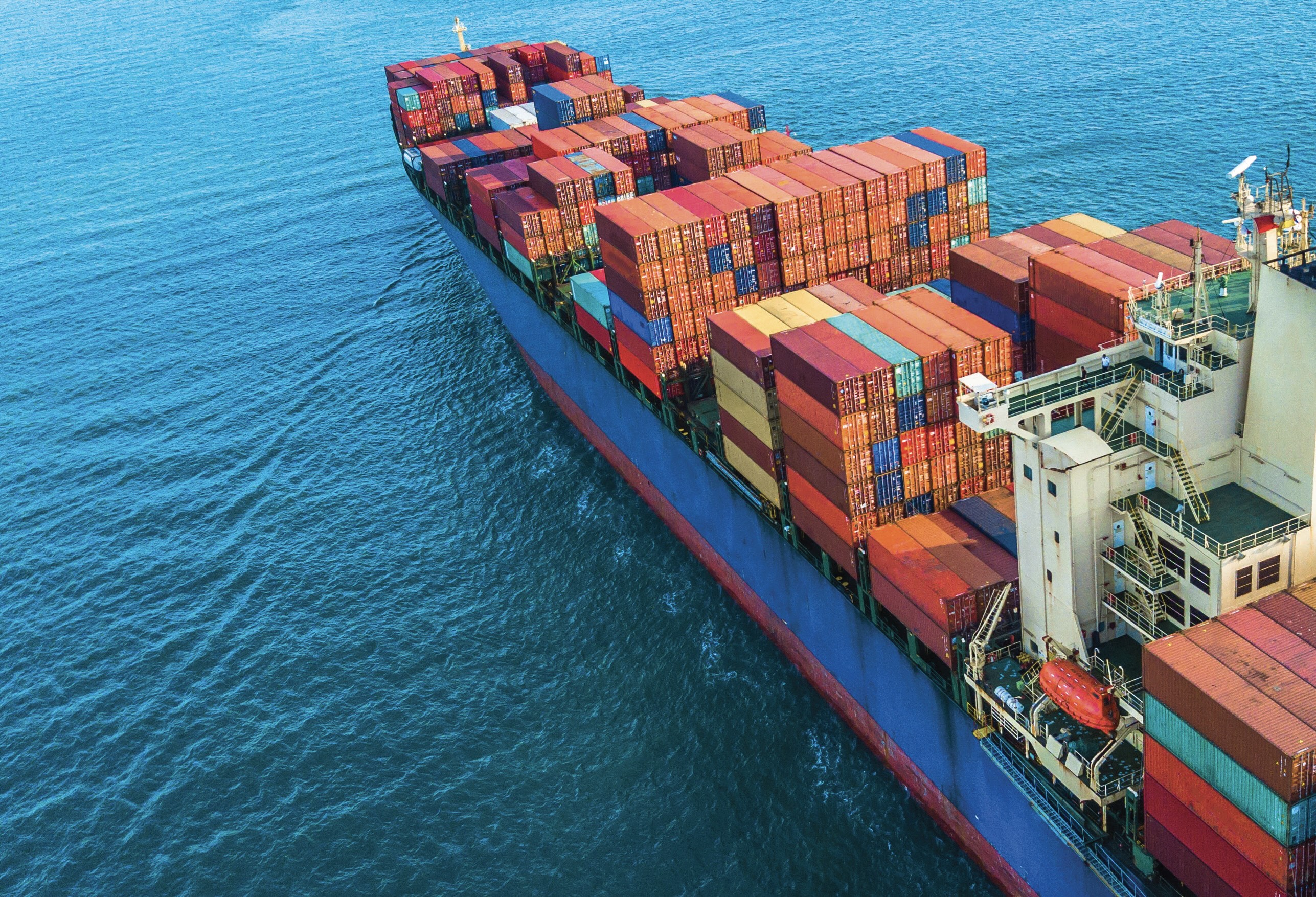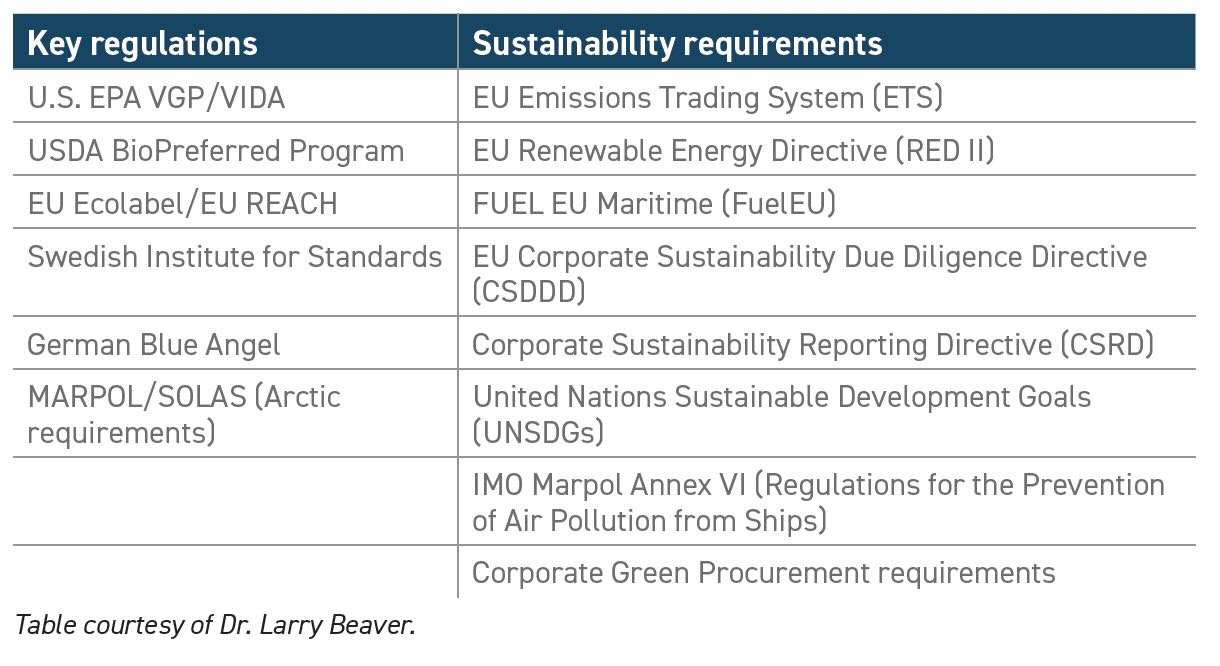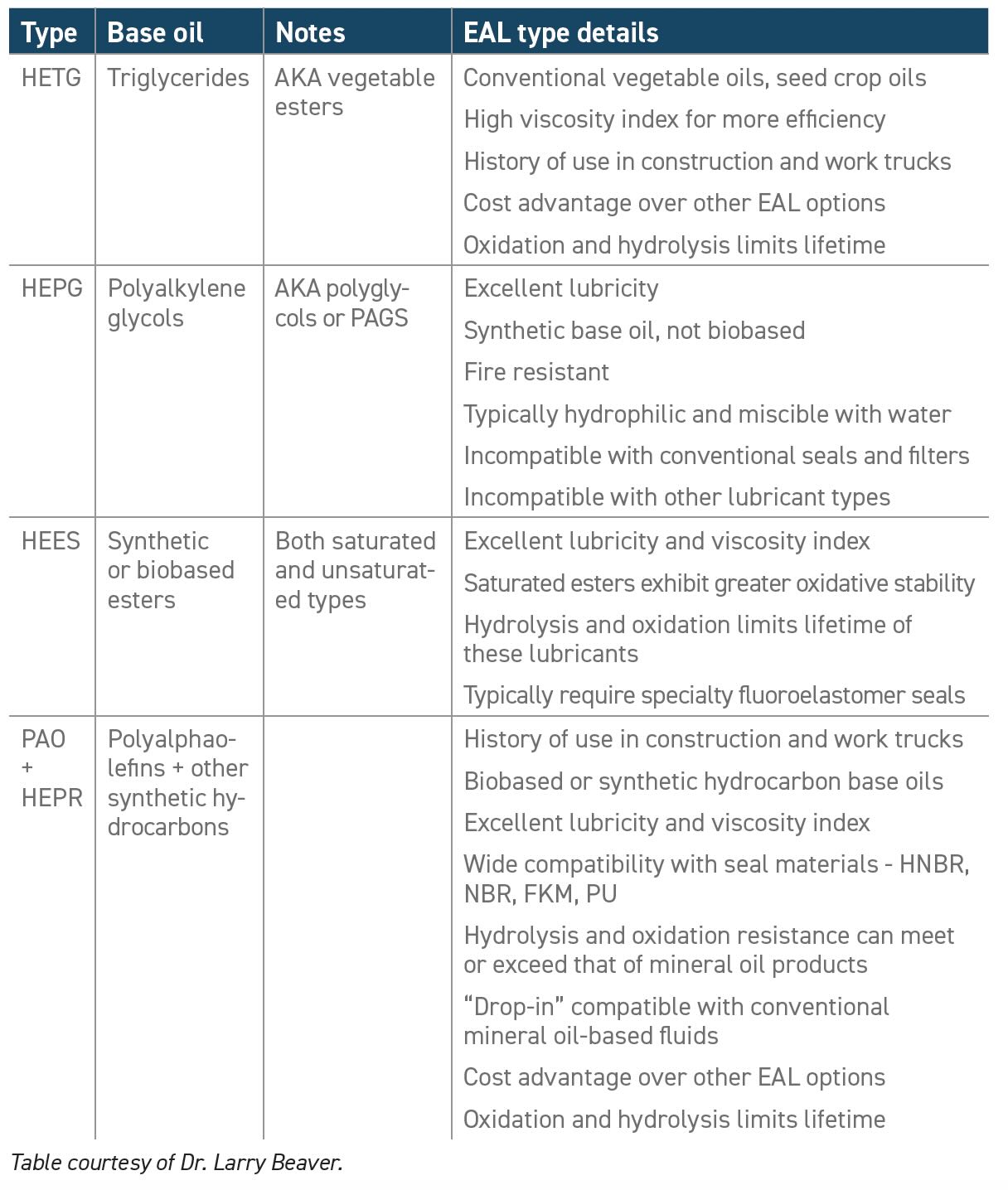Environmentally acceptable lubricants
By Dr. Yulia Sosa, Contributing Editor | TLT Feature September 2025
Lubricant users are navigating the changing product landscape for a cleaner future.

KEY CONCEPTS
• Generally, “environmentally acceptable lubricant” (EAL) is a generic term to designate a lubricant having a reduced environmental impact compared to traditional technologies. Different governing bodies have varying criteria for classifying a lubricant as an EAL.
• EAL market reports consistently point to strong and sustained growth, driven by tightening environmental regulations and rising demand for sustainable solutions.
• Today’s EAL formulations offer vastly improved performance, stability and environmental compatibility, meeting stringent industry standards without compromising on efficiency or equipment protection, compared to products of the past.
Environmentally acceptable lubricants (EALs) have been growing in interest due to the need, request and requirements from law as well as an increasing demand for fluids with a superior environmental footprint.
The introduction of the Vessel General Permit (VGP) in 2013 was a significant shift in the industry. This required that over time, all sea vessels coming into U.S. territorial waters had to start using EALs in oil-to-sea contact applications—like stern tube fluids, for example.
The key to formulation is the selection of fitting components ranging from base stocks to additives; as around 80%-90% of the finished fluids will consist of the base stock, this component will have the biggest impact on the overall rating of the oil. Base oil technologies need to be evaluated carefully and checked for environmental compliance.
Also, the usage of harmful and toxic additives must be avoided. There is an increase of additive chemistries that have been used for decades, which are being re-evaluated and often banned for future usage in certain application areas (e.g., aminic antioxidants).
The biggest challenge for EALs is still the perception that they might be lacking performance compared to fluids that have been used in the industry for years—especially formulations based on unsaturated ester chemistry or vegetable oils which have faced concerns about long-term oxidative and hydrolytic stability, material compatibility, etc. Formulators and end-users need to be convinced by test data that robust technologies are available which fulfil high performance requirements along with a beneficial environmental profile.
This article is intended to show that EALs can combine the needs for better ecotoxicity and biodegradation, summarized in simple terms as having effective environmental friendliness and necessary technical performance level.
EAL definition
When it comes to EAL’s definition, it must be noted that not all the biolubricants are EALs, and not all EALs are biolubricants. The EAL designation depends on multiple criteria.
STLE member Stephen Sumner, chief chemist at Vickers Oils, shares that VGP’s definition of an EAL allowed the use of various green labels including the European Ecolabel (EEL) and the Swedish Institute for Standards (SIS); however with the Vessel Incidental Discharge Act (VIDA), the U.S. Environmental Protection Agency (EPA) is proposing to stop listing specific labeling programs that identify EALs. “Why? These labeling programs are created and managed by outside organizations (not EPA or the U.S. Coast Guard). EPA has no control over how those outside organizations change their criteria for what gets labeled as environmentally acceptable,” Sumner explains.
He adds: “EPA will:
• Set clear environmental criteria (like biodegradability, toxicity and bioaccumulation).1
• Allow any labeling program to be considered acceptable as long as it meets or exceeds those criteria.
EPA wants to avoid endorsing labeling programs it can’t oversee. Instead, it will require that any program meet specific environmental standards. This gives clarity to labeling organizations and vessel operators, without EPA having to manage outside entities changing rules.”
STLE member Dr. Larry Beaver, vice president, research and development, with RSC Bio Solutions, says the U.S. VGP definition of EAL is the following:
• Biodegradable 60% in 28 days
• Minimally toxic
• Not bioaccumulative
For additional things to consider, Beaver adds: “Beyond what the EPA defines as an EAL, we also consider renewability or biobased carbon content, not sheening characteristics and overall safety for workplace environment, use of raw materials and components, etc.”
According to Beaver, that is the reason why VGP uses existing ecolabels around the world like the EEL or SIS. Countries/regions have different ideas as to what constitutes “environmentally” friendly methods. In general, most if not all systems establish biodegradability, toxicity and bioaccumulation targets that formulators must meet. The requirements differ in stringency (aquatic toxicity versus repro toxicity, etc.).
Sumner adds that current definition of EAL—as per various environmental regulatory standards authorities such as VIDA (VGP), EEL, SIS and Blue Angel, amongst others—is described as a type of lubricant designed to minimize environmental impact and that it must have the following characteristics:
• Break down naturally in the environment, reducing the risk of long-term pollution (biodegrade)
• Be formulated to be minimally toxic to aquatic and terrestrial life (low toxicity)
• Not built up in the tissues of living organisms, preventing harmful effects up the food chain (non-accumulative)
• Designed to meet or exceed performance standards of traditional lubricants (performance)
Siegfried Lucazeau, marketing and project manager at NYCO, shares that EAL is above all a generic term to designate a lubricant having a reduced environmental impact compared to traditional technologies. He says, “Usually this notion of environmental impact does not encompass any consideration related to carbon emissions: it is understood as the immediate impact on the environment (i.e., bioaccumulation effects, toxicity to aquatic organisms, etc.).” He continues: “Having said that, the EPA, in the 2013 VPG (now VIDA), uses the term EAL to describe the type of lubricant that must be used on vessels entering U.S. waters; it is defined as a biodegradable, non-bioaccumulative and non-ecotoxic lubricant.”
Lucazeau states: “It is noteworthy that in the EPA’s definition, there is no requirement on the use of carbon of renewable origin—even though this feature is often thought as being an inseparable part of an EAL. Using carbon of renewable origin and showing a low carbon footprint, it is likely that in the near future an EAL will be understood as a lubricant having a reduced impact on the environment.”
EAL market demand
Sumner shares that according to Fortune Business Insights,2 the global EAL market was valued at $3.26 billion in 2023 and projected to grow by compound annual growth rate (CAGR) of 4.7% to an estimate value of $4.90 billion by 2032. Cons & Insights3 indicates that the 2023 market size was $2.5 billion but will experience CAGR of 7%, given a 2033 market size of $5.01 billion.
While estimates of the global market value and projected growth rates for EALs vary depending on the source, all reports consistently point to strong and sustained growth, driven by tightening environmental regulations and rising demand for sustainable solutions.
The market demand for EALs varies significantly by region, which is driven by different regulatory environments, industrial activities and environmental awareness levels:
• Europe. Europe is a leading market for EALs with countries such as Germany and the Nordic nations at the forefront, having a 21.2% share of the global market.3 Key factors are the increasing desire for companies to follow best environmental practices and the increasing drive toward sustainable practices. The region also has a high adoption rate in forestry, agriculture and manufacturing.
• North America. The demand for EALs is strong, approximately 44.8% market share2 particularly in the U.S. and Canada driven by stringent environmental regulations and a high level of environmental awareness. The marine and industrial sectors are major consumers.
• Asia-Pacific. The market is growing, having a 15% market share in 20233 especially in countries like China, Japan, India and South Korea. While regulatory frameworks are not as stringent as in Europe or the U.S., increasing industrialization and environmental concerns are boosting demand. For the most part, main consumers align with the European Union (EU) and North America.
• Latin America. The demand is moderate, 7.4% share in 20233 but growing, particularly in Brazil and Mexico. Increasing awareness of both environmental and sustainability are slowly increasing demand. The South America biolubricants market is estimated to register a CAGR of 8.7% during the forecasted period of 2023 to 2032 and is estimated to reach $314.6 million by 2032.4
• Middle East and Africa. The market is in its infancy, still with a global market share of 8.0%4 but has potential for growth.
We expect the demand for EALs to expand as more regions begin to adopt environmental regulations and industries recognize the benefits of sustainable lubricants.
Lucazeau shares that the market demand for EALs has been depicted as growing for at least 20 years, “even though we have not seen any surge in the use of such lubricants. According to Kline + Company (see the Market Trends article), who expressed their view in the press recently, biolubricants (another term for biosourced EALs) will experience a significant growth over the coming years, but since they are starting from such small volume, they will remain a niche application.”
He says that the main driver for EAL demand is indeed the VGP—a compelling regulation. Lucazeau clarifies: “But it is commonly agreed on the market that in the absence of obligation to use an EAL, the market will not convert to them massively. In Europe, in some public tenders or in sensitive areas (water catchment areas), EALs (defined as EEL-certified lubricants) are a requirement, but this does not generate a significant demand.”
EAL market drivers
When it comes to market drivers, Sumner shares that while environmental legislation is the primary driver of growth in the EAL market, long-term demand will also depend on factors like performance improvements, industry awareness and broader corporate commitments to environmental and sustainability goals.
1. Increasing environmental awareness. This includes awareness of environmental issues globally and an increase in sustainable practices. EALs align well with these goals.
2. Technological advancements. Advances in the formulation of EALs are improving their performance characteristics, providing the improvement in performance more akin with traditional lubricants and beyond.
3. Market expansion. EALs are finding applications in various industries beyond marine, which is helping to increase their market share.
4. Consumer demand. Increase in consumer demand for ecofriendly products is driving companies to incorporate EALs into their product lines. This is clearly driven in part by the reputational value of demonstrating environmental responsibility.
5. Regulatory incentives. This is particularly evident in Europe, where national and international labeling programs promote their adoption.
Lucazeau says that the drivers for market demand and acceptance of EALs revolve around regulation (political will), cost and technical performance—a difficult equation to resolve. “There is also a lack of knowledge and experience of the use of such lubricants which may further delay conversion,” he adds.
Per Beaver, in addition to the 2013 U.S. EPA VGP and its successor VIDA, which further expands required use of EALs, there are several regulations and standards driving the change to more sustainable and EALs around the world today (see Table 1):
• Growth of EALs is well beyond compliance solutions because the high performance levels of some EALs, like Hydraulic Environmental Polyalphaolefins (PAO) and Related products (HEPR) and PAO-related technologies, can solve challenging problems for operators with environmental advantages as well as lower overall lower operating costs and risk mitigation in sensitive areas, including marine construction and engineering projects, dredging, port operations, offshore energy and blue water marine.
• Not all EALs are the same and will perform the same in harsh operating environments. It’s important to understand ISO15380 for EALs and the chemistry differences in each base oil category and how that directly predicts and translates to performance in applications (see Table 2).

Table 1. EAL key regulations and sustainability requirements

Table 2. EAL overview
EAL compatibility and technical requirements
Sumner says that there is little comparison between the EALs available 30-plus years ago and those available now, as today’s formulations offer vastly improved performance, stability and environmental compatibility, meeting stringent industry standards without compromising on efficiency or equipment protection. He shares: “The compatibility of environmental and technical requirements for EALs is generally good, but it involves balancing several factors as following:
• Biodegradability versus performance. EALs must be readily biodegradable to minimize environmental impact. However, achieving high biodegradability can sometimes compromise certain performance aspects, such as oxidative stability and longevity. Advances in base oil chemistries, such as synthetic esters, PAOs and polyalkylene glycols, to name a few, are helping to bridge this gap.
• Low toxicity versus effectiveness. EALs are designed to be minimally toxic to aquatic and terrestrial life. This requirement can limit the use of certain additives that enhance lubricant performance. Increasing hazard classification only makes the formulators job more difficult with the decreasing palate of additives.
• Non-bioaccumulative versus durability. EALs should not accumulate in the tissues of living organisms. Ensuring non-bioaccumulative properties while maintaining durability is a technical challenge that is being addressed through innovative chemical engineering.
• Regulatory compliance versus cost. Meeting stringent environmental regulations can increase finished product cost. However, the long-term benefits of using EALs, such as reduced environmental cleanup costs and improved sustainability, often outweigh these initial expenses.”
Overall, Sumner explains that while there are challenges in aligning environmental and technical requirements, ongoing development and technological advancements are making it increasingly possible to produce EALs that meet both criteria effectively.
Lucazeau shares: “I believe that the days when using an EAL or biolubricant meant poor performance are over. It may still be true for some, but a number of new technologies have appeared, and we are now definitely able to combine excellent environmental profile with a high level performance. It is a matter of choosing the right chemistry for the base oil. Synthetic esters are a very good example: aviation oils that are exposed to extreme temperature conditions use esters that may be biodegradable, non-toxic to aquatic species and use renewable carbon.” He adds: “With regards to additives, the requirement for a formulation to be an EAL may generate some restrictions in the variety of usable compounds. For instance, the positive list of additives usable in EEL compliant lubricants (the Lubricant Substance Classification [LuSC] list) may sometimes be a limitation when specific performance features are needed for the application.”
Summary
EALs are no longer a trade-off between performance and sustainability. With innovative base oils, additive solutions and continuous strengthening of regulations and legislations around the world, EALs are evolving into high-performing products with a strong demand growth, which are backed by corporate, social and ecological responsibility goals to enable a true zero emission future.
REFERENCES
1. https://www.epa.gov/vessels-marinas-and-ports/vessel-incidental-discharge-act-vida
2. https://www.fortunebusinessinsights.com/environmentally-acceptable-lubricants-market-107281
3. https://www.factmr.com/report/environmentally-acceptable-lubricants-market
4.
www.marketresearchfuture.com/press-release/south-america-bio-lubricants-market
Dr. Yulia Sosa is a freelance writer based in Peachtree City, Ga. You can contact her at dr.yulia.sosa@gmail.com.